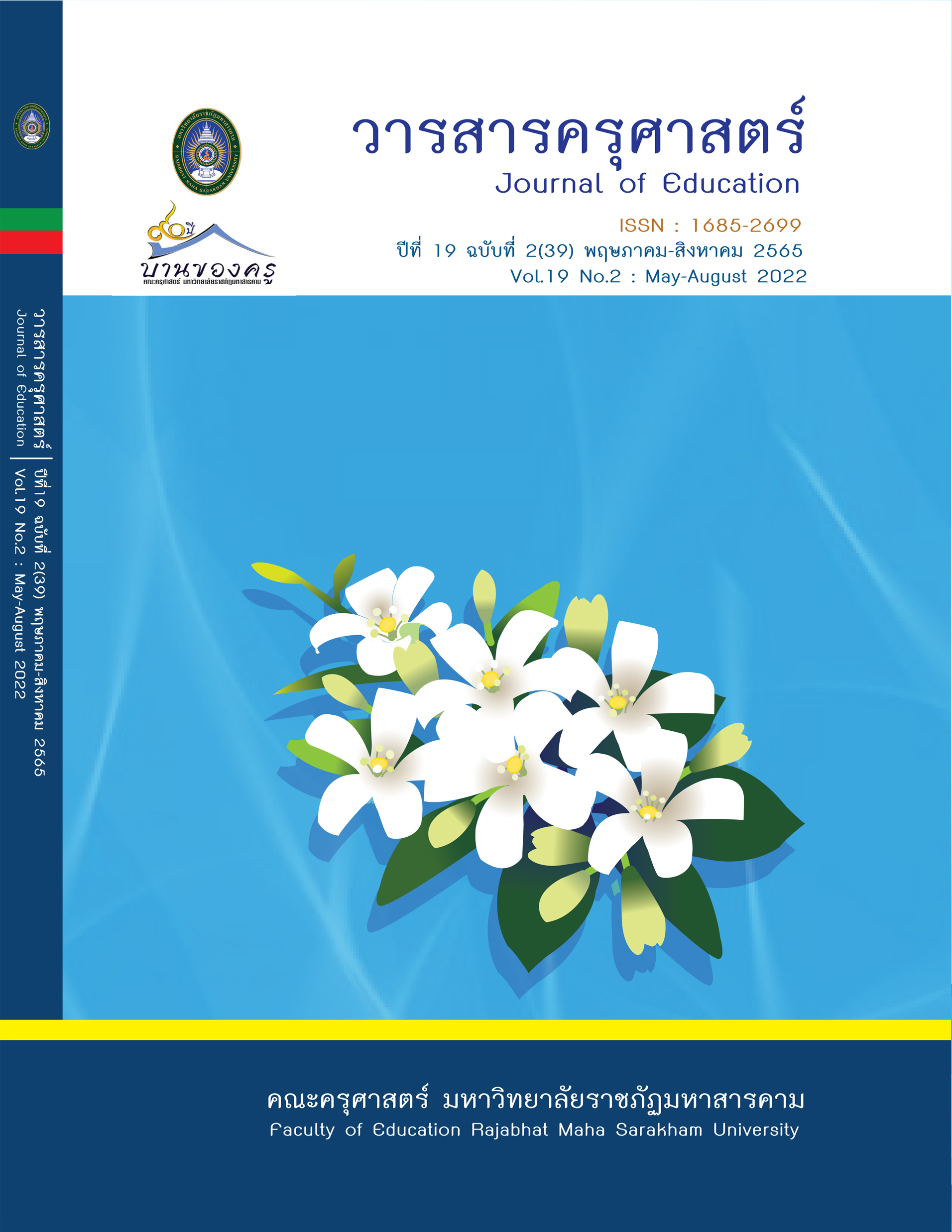Blended Learning by Using Polya's Process to improve Mathematics Problems Solving for Phathomseuksa 5 Students, Anuban Thasapol Suksa School
Main Article Content
Abstract
The purposes of this research aimed to: 1) examine, explore and encourage the Polya’s conceptual, mathematic problem-solving process. 2) study students’ ability for math problems solving. 3) investigate academic achievement with the model, and 4) study the students’ satisfaction toward the model. The sample consisted of 23 Phathomseuksa 5 students at Anuban Thasapolsuka school. The research instruments were:
1) The lesson plans, 2) The student’s journal writing, 3) A Mathematics problem solving ability test 4) an achievement test, and 5) The students’ satisfaction form. The statistics used in the research were mean and standard deviation.
The results of the research were as follows: 1) there were four steps of blended learning model, which supported the mathematics problems solving reduced the problems on time and place. According to each step of the learning activity enhanced the students problems solving step by step, more over the students were motivated to engage their learning activities. These improved the students mathematics problems solving ability at a good level, 2) the students’ mathematics problem solving ability was as the criteria, 3) the students’ achievement test mean scores were as the school criteria at 70%, and 4) the students’ satisfaction toward the blended learning model was at the high level.
Article Details

This work is licensed under a Creative Commons Attribution-NonCommercial-NoDerivatives 4.0 International License.
ข้อกำหนดเบื้องต้นที่ผู้นิพนธ์(ผู้ส่งบทความ) ควรทราบ
1. ผู้นิพนธ์ที่ประสงค์จะลงตีพิมพ์บทความกับวารสาร ตั้งแต่เดือนมกราคม 2563 เป็นต้นไป ให้ใช้รูปแบบใหม่ (Template 2563) โดยสามารถดูตัวอย่างได้ที่เมนู GUIDELINES
2. จะตีพิมพ์และเผยแพร่ได้ ต้องผ่านการประเมินจากผู้ทรงคุณวุฒิ (Peer Review)
3. การประเมินบทความโดยผู้ทรงคุณวุฒิ (Peer Review) เป็นแบบ Double Blind
4. การอ้างอิงบทความใช้หลักเกณฑ์ APA (American Psychological Association) คลิก
5. บทความถูกปฏิเสธการตีพิมพ์ ไม่ผ่านการประเมิน ผู้นิพนธ์ขอยกเลิกเองหรือชำระเงินก่อนได้รับการอนุมัติ ทางวารสารไม่มีนโยบายการคืนเงิน
References
ชัยยศ จระเทศ. (2558). การส่งเสริมความสามารถในการคิดแก้ปัญหา ด้วยการจัดการเรียนรู้แบบผสมผสาน
โดยใช้ปัญหาเป็นฐาน ห้องเรียนพิเศษวิทยาศาสตร์ สำหรับนักเรียนชั้นมัธยมศึกษาปีที่ 5
โรงเรียนวาปีปทุม [วิทยานิพนธ์ครุศาสตรมหาบัณฑิต ไม่ได้ตีพิมพ์]. มหาวิทยาลัยราชภัฏมหาสารคาม.
ธัญญวัจน์ บุตรราช. (2563). การเสริมสร้างความสมารถในการแก้ปัญหาทางคณิตศาสตร์ด้วยกิจกรรมการเรียนรู้
ตามแนวคิดของโพลยาร่วมกับสื่อสังคม ชั้นประถมศึกษาปีที่ 6 โรงเรียนบ้านหนองปาดฟาน
[วิทยานิพนธ์ครุศาสตรมหาบัณฑิต ไม่ได้ตีพิมพ์]. มหาวิทยาลัยราชภัฏมหาสารคาม.
นิธินันท์ กลั่นคูวัฒน์. (2559). ผลการจัดการเรียนการสอนแบบ TAI ร่วมกับกระบวนการแก้ปัญหาของโพลยาที่ส่งผล
ต่อความสามารถในการแก้ปัญหาและผลสัมฤทธิ์ทางการเรียนคณิตศาสตร์ เรื่องการแก้โจทย์สมการเชิง
เส้นตัวแปรเดียว ของนักเรียนชั้นมัธยมศึกษาปีที่ 2 [วิทยานิพนธ์ศึกษามหาบัณฑิต ไม่ได้ตีพิมพ์].
มหาวิทยาลัยบูรพา.
ประทวน คล้ายศรี .(2560). การพัฒนารูปแบบการเรียนการสอนโดยใช้แนวคิดการเรียนรู้แบบผสมผสานร่วมกับ
แนวคิดอภิปัญญาสำหรับนักศึกษาคณะครุศาสตร์มหาวิทยาลัยราชภัฏภาคตะวันออกเฉียงเหนือ
[วิทยานิพนธ์ศึกษามหาบัณฑิต ไม่ได้ตีพิมพ์]. มหาวิทยาลัยราชภัฏภาคตะวันออกเฉียงเหนือ.
ปิยธิดา โพธิ์ประภา. (2558). การพัฒนาบทเรียนแบบผสมผสาน เรื่อง ลำดับและอนุกรม เพื่อพัฒนาทักษะ
กระบวนการทางคณิตศาสตร์ สำหรับนักเรียนชั้นมัธยมศึกษาปี ที่ 5 [วิทยานิพนธ์ศึกษามหาบัณฑิต
ไม่ได้ตีพิมพ์]. มหาวิทยาลัยนเรศวร.
มนต์ชัย เทียนทอง. (2549). Blended Learning: การเรียนรู้แบบผสมผสานในยุค ICT (ตอนที่ 1). วารสารวิชาการครุศาสตร์
อุตสาหกรรม, 1(2), 48-57.
วันเพ็ญ รังคพุทธมานะ. (2559). การพัฒนารูปแบบการสอนโดยใช้แนวคิดของโพลยาร่วมกับการใช้เทคนิคผังกราฟิก
เพื่อพัฒนาผลสัมฤทธิ์ทางการเรียนคณิตศาสตร์ของนักเรียนชั้นประถมศึกษาปีที่ 5 [วิทยานิพนธ์
ครุศาสตรมหาบัณฑิต ไม่ได้ตีพิมพ์]. มหาวิทยาลัยราชภัฏบ้านสมเด็จเจ้าพระยา.
สถาบันส่งเสริมการสอนวิทยาศาสตร์และเทคโนโลยี. (2560). คู่มือการใช้หลักสูตรกลุ่มสาระคณิตศาสตร์
(ฉบับปรับปรุง พ.ศ. 2560). โรงพิมพ์ชุมนุมสหกรณ์การเกษตรแห่งประเทศไทย จำกัด
Bersin, J. (2004). The blended learning book: Best practices, proven methodologies, and lessons learned. San
Francisco: Pfeiffer.
Polya, G. (1957). How to solve it (3rd ed.). Double Day.
Garnham, C., & Kaleta, R. (24, Oct 2002). Introduction to Hybrid Courses. Retrieved.
http:// www.uwsa.edu/ttt/articles/ garnham.htm.
Kemmis, S., & McTaggart, R. (1988). The Action Research Planner (3rd ed.). Geelong, Australia: Deakin University Press
Lesher, Ronald E.(1971). A Study of logical thinking in Grades for though seven. Dissertation Abstracts
International. 32 :2487-A.
Rovai, A. P. & Jordan, H. (2004). Blended Learning and Sense of Community: A Comparative Analysis with
Traditional and Fully Online Graduate Courses. The International Review of Research in Open and
Distributed Learning 2004, 5(2), 1-13.


